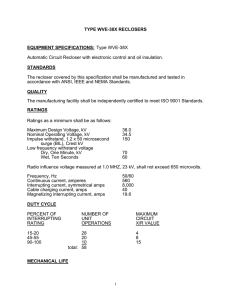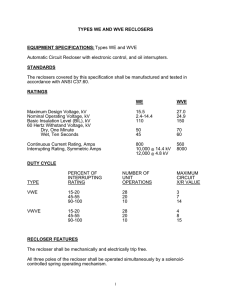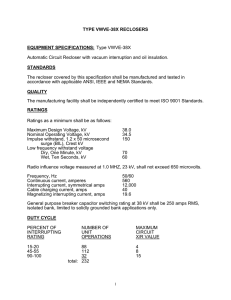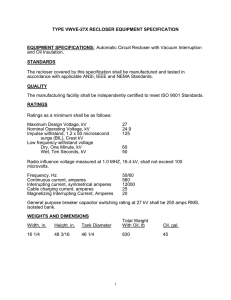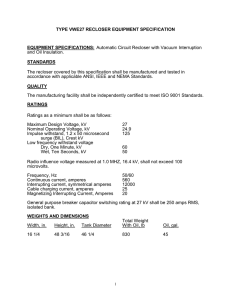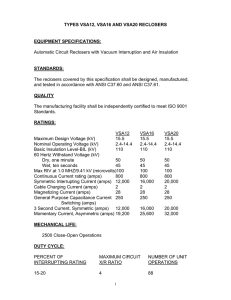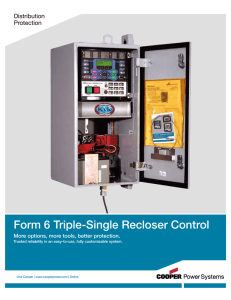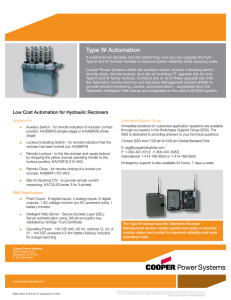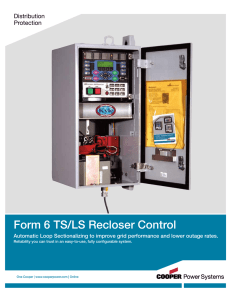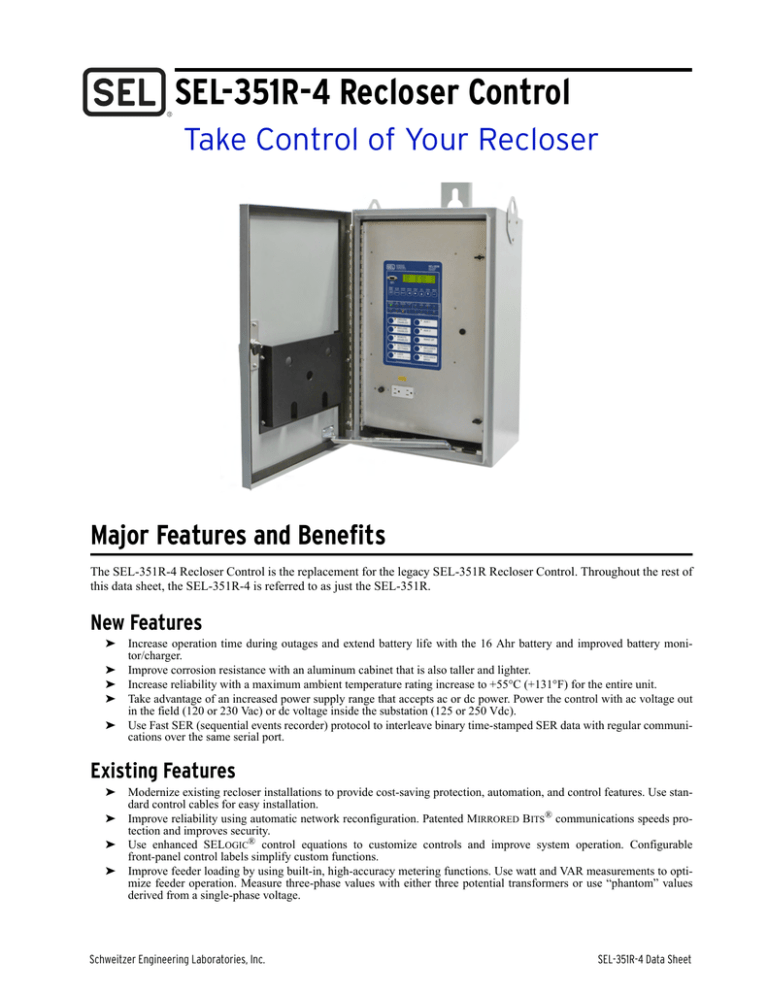
SEL-351R-4 Recloser Control
Take Control of Your Recloser
Major Features and Benefits
The SEL-351R-4 Recloser Control is the replacement for the legacy SEL-351R Recloser Control. Throughout the rest of
this data sheet, the SEL-351R-4 is referred to as just the SEL-351R.
New Features
➤
➤
➤
➤
➤
Increase operation time during outages and extend battery life with the 16 Ahr battery and improved battery monitor/charger.
Improve corrosion resistance with an aluminum cabinet that is also taller and lighter.
Increase reliability with a maximum ambient temperature rating increase to +55°C (+131°F) for the entire unit.
Take advantage of an increased power supply range that accepts ac or dc power. Power the control with ac voltage out
in the field (120 or 230 Vac) or dc voltage inside the substation (125 or 250 Vdc).
Use Fast SER (sequential events recorder) protocol to interleave binary time-stamped SER data with regular communications over the same serial port.
Existing Features
➤
➤
➤
➤
Modernize existing recloser installations to provide cost-saving protection, automation, and control features. Use standard control cables for easy installation.
Improve reliability using automatic network reconfiguration. Patented MIRRORED BITS® communications speeds protection and improves security.
Use enhanced SELOGIC® control equations to customize controls and improve system operation. Configurable
front-panel control labels simplify custom functions.
Improve feeder loading by using built-in, high-accuracy metering functions. Use watt and VAR measurements to optimize feeder operation. Measure three-phase values with either three potential transformers or use “phantom” values
derived from a single-phase voltage.
Schweitzer Engineering Laboratories, Inc.
SEL-351R-4 Data Sheet
2
Functional Overview
Bus
ANSI NUMBERS/ACRONYMS AND FUNCTIONS
S
27
P
67 GQ
RECLOSER
67N
59
O
U
81
P
P
50 GQ
50N
51 GQ
51N
Residual
3
P
G
Q
25
79
27
59
1
BRM
MET
DFR
SER
HMI
LGC
LOC
85
RIO
1
*
Figure 1
Synchronism Check*
27
Undervoltage
50N
Neutral Overcurrent
50 (P, G, Q)
Overcurrent (Phase, Ground, Neg. Seq.)
51N
Neutral Time-Overcurrent
51 (P, G, Q)
Time-Overcurrent (Phase, Ground, Neg. Seq.)
59
Overvoltage
59 (P, G, Q)
Overvoltage (Phase, Ground, Neg. Seq.)
67N
Directional Neutral Overcurrent*
67 (P, G, Q)
Directional Overcurrent (Phase, Ground, Neg. Seq.)*
79
Autoreclosing
81 (O, U)
Over-/Underfrequency
85 RIO
SEL MIRRORED BITS® Communications
DFR
Event Reports
HMI
Operator Interface
LGC
SELOGIC® Control Equations
MET
High-Accuracy Metering
SER
Sequential Events Recorder
ADDITIONAL FUNCTIONS
4
Line
25
EIA-232
EIA-485*
IRIG-B
BRM
Breaker Wear Monitor
LDP
Load Data Profiling*
LOC
Fault Locator*
* Optional Feature
Functional Diagram
Functional Replacement for Traditional Recloser Control
EZ Settings for Basic
Recloser Functions
For traditional recloser functions, the SEL-351R is easy
to set. Only settings such as minimum trip pickup, curve
type, and reclose interval are necessary. These settings
are made at an EZ (easy) access level. SELOGIC control
equations cannot be changed at this access level.
Control logic is preconfigured at the factory. To
customize the logic for advanced functions, the SELOGIC
control equations must be reprogrammed.
Reclosing
The SEL-351R can reclose as many as four (4) times.
This allows as many as five (5) operations of any combination of fast and delay curve overcurrent elements. Each
reclose interval can be set for as many as 999,999 cycles
(more than 4.5 hours), if necessary.
After a reclose interval has timed out, the control waits a
user-set time (close power wait time) for the presence of
closing power before proceeding with the autoreclose.
The recloser needs either primary or secondary
(e.g., 120 Vac) voltage to provide the closing power,
SEL-351R-4 Data Sheet
depending on how the recloser is equipped. The 120 Vac
power into the SEL-351R is an indication of the presence
of this primary or secondary voltage. The close power
wait time has the same 999,999-cycle setting range as the
reclose interval.
The reset times are set separately for reset timing for an
autoreclose and reset timing for a manual/remote close
from lockout. Traditionally, the reset time for a
manual/remote close from lockout is set for less than the
reset time for an autoreclose. The reset times have the
same 999,999-cycle setting range.
Front-panel LEDs track the control state for
autoreclosing: RESET, CYCLE, or LOCKOUT (see Figure 14
and Table 4).
Sequence coordination logic is enabled to prevent the
SEL-351R from tripping on its fast curves for faults
beyond a downstream recloser.
Customize reclosing logic by using SELOGIC control
equations. Use programmable counters, latches, logic
functions, and analog compare functions to optimize
control actions.
Schweitzer Engineering Laboratories, Inc.
3
C
Source B
A
120 Vac
Close Power
(if recloser
is equipped)
R
E
C
L
O
S
E
R
microprocessor-based control designations. For example,
a given traditional recloser curve has the following two
designations:
Load
120 Vac Power
SEL-351R
Optional 3-Phase Voltage
(connect to voltage
channels V1, V2, and V3)
Control Cable
•
•
•
•
Trip and Close
Breaker Status
IA, IB, IC, IN
24 Vdc
Connect to extra
voltage channel VS
for synchronism check
and line voltage check
(channel VS connects
to A-phase in this example)
• Fault Locating
• Sensitive, Yet Secure,
Fault Detection
• Complete Metering
Figure 2 Connect True Three-Phase and
Synchronism-Check Voltages to the SEL-351R
Overcurrent Protection
Older electronic control designation:
A
Newer microprocessor-based control designation:
101
Traditional recloser curve A and 101 are the same curve.
Use either designation in making curve settings in the
SEL-351R.
Modify fast and delay curves (including U.S. or IEC
curve choices) with the following traditional recloser
control curve modifiers:
➤ constant time adder—adds time to curve
➤ vertical multiplier (time dial)—shifts whole curve
up or down in time
➤ minimum response time—holds off curve tripping
for minimum time
➤ high-current trip—instantaneous trip with optional
time delay
➤ high-current lockout—high-set lockout threshold
Front-panel target LEDs indicate any overcurrent trip in
general (TRIP LED) and then discriminate a fast-curve
trip (FAST CURVE LED) or a high-current trip (HIGH
CURRENT LED). See Figure 14 and Table 4.
Fast and Delay Curves
Use up to five cumulative fast and delay curve operations
for phase and ground overcurrent protection. For a nominal recloser CT ratio of 1000:1, these curves can be set as
sensitive as 50 A and 5 A primary for phase and ground
overcurrent protection, respectively.
Table 1
52
SEL-351S
Curve Choices
All traditional recloser curves
A, B, C, D, E, F, G, H, J, KP,
L, M, N, P, R, T, V, W, Y, Z, 1,
2, 3, 4, 5, 6, 7, 8, 8PLUS, 9,
KG, 11, 13, 14, 15, 16, 17, 18
U.S. curves
moderately inverse, inverse,
very inverse, extremely
inverse, short-time inverse
IEC curves
class A (standard inverse),
class B (very inverse), class C
(extremely inverse), long-time
inverse, short-time inverse
Any fast or delay curve (phase or ground) can be set with
any of the curves in Table 1. The U.S. and IEC curves
conform to IEEE C37.112-1996, IEEE Standard
Inverse-Time Characteristic Equations for Overcurrent
Relays.
The traditional recloser curve choices listed in Table 1
use the older electronic control designations. The
SEL-351R
also
works
with
the
newer
Schweitzer Engineering Laboratories, Inc.
SEL-351R
t
Delay
Curves
Curve Choices in the SEL-351R
Curve Type
Recloser
Fast
Curves
Retrofit older
existing reclosers with
SEL-351R Recloser Control
I
Figure 3
Coordinate Overcurrent Protective Devices
The SEL-351R has two reset characteristic choices for
each time-overcurrent element. One choice resets the
elements if current drops below pickup for at least one
cycle. The other choice (for U.S. or IEC curves only)
emulates electromechanical induction disc elements,
where the reset time depends on the time-dial setting, the
percentage of disc travel, and the amount of current.
Sensitive Earth
Fault (SEF) Element
A sensitive earth fault (SEF) element with time delay (as
long as 16,000 cycles) can be set as sensitive as 5 A primary (assuming nominal recloser CT ratio of 1000:1).
Current channel IN with a 0.05 A secondary nominal rating provides this sensitivity (see Wiring Diagram on
page 13).
SEL-351R-4 Data Sheet
4
The front-panel SEF LED indicates any SEF element trip
(see Figure 14 and Table 4).
Custom Overcurrent Protection
Customize the overcurrent protection by reprogramming
the corresponding SELOGIC control equations.
Metering and Monitoring
Complete Metering Capabilities
The SEL-351R provides extensive and accurate metering
capabilities. See Specifications on page 15 for metering
and power measurement accuracies.
Metered quantities include phase voltages and currents
(including demand currents); sequence voltages and
currents; power (including demand), frequency, and
Table 2
energy; and maximum/minimum logging of selected
quantities (see Table 2). The recloser control reports all
metered quantities in primary quantities (current in
A primary and voltage in kV primary).
Assign voltage inputs V1, V2, V3 and current inputs I1, I2,
I3 (see Figure 15) separately to phases A, B, C—no
wiring changes required.
Meteringa
Quantities
Description
Currents IA,B,C,N, IG
Input currents, residual ground current (IG = 3I0 = IA + IB + IC).
Voltages VA,B,C, VS
Wye-connected voltage inputs, synchronism-check voltage input.
Power MWA,B,C,3P , MVARA,B,C,3P
Single- and three-phase megawatts and megavars.
Energy MWhA,B,C,3P , MVARhA,B,C,3P
Single- and three-phase megawatt-hours and megavar-hours.
Power Factor PFA,B,C,3P
Single- and three-phase power factor; leading or lagging.
Sequence I1, 3I2, 3I0
Positive-, negative-, and zero-sequence currents.
Frequency, FREQ (Hz)
Instantaneous power system frequency (monitored on channel V1).
If true three-phase voltage is not connected, the voltage (VA,B,C) uses phantom voltages derived from a single-phase voltage to calculate
MW/MVAR, MWh/MVARh, and power factor metering values.
Recloser Wear Monitor
Reclosers suffer mechanical and electrical wear every
time they operate. The recloser wear monitor measures
unfiltered ac current at the time of trip and the number of
close-to-open operations as a means of monitoring this
wear. Every time the recloser trips, the recloser control
records the magnitude of the raw current in each phase.
This current information is integrated on a per-phase basis.
When the result of this integration exceeds the threshold
the recloser wear curve establishes, the SEL-351R
asserts a logic point for the affected phase. This logic
point can be routed for alarming or to modify reclosing
(e.g., shorten the number of reclosures). This method of
monitoring recloser wear is based solidly on methods of
breaker rating from breaker manufacturers.
Figure 4 shows three set points necessary to emulate a
breaker wear curve. Program the set points in Figure 4 to
customize the recloser wear curve.
SEL-351R-4 Data Sheet
The SEL-351R sets setpoints automatically according to
recommendations for reclosers in ANSI C37.61-1973.
Only the recloser type (oil or vacuum) and the interrupt
rating are necessary settings.
(COSP1, KASP1)
Close-to-Open (C/O Axis)
a
(COSP2, KASP2)
(COSP3, KASP3)
kA Interrupted (kA Axis)
Figure 4
Recloser Contact Wear Curve and Settings
Schweitzer Engineering Laboratories, Inc.
5
Fault Locator
The SEL-351R provides an accurate estimate of fault location even during periods of substantial load flow. The fault
locator uses fault type, replica line impedance settings, and fault conditions to develop an estimate of fault location without communications channels, special instrument transformers, or prefault information. This feature contributes to efficient dispatch of line crews and fast restoration of service. The fault locator requires three-phase voltage inputs.
Automation
Flexible Control Logic
and Integration
The SEL-351R has four independently operated serial
ports: one EIA-232 port on the front and two EIA-232
ports and one optional EIA-485 port on the side. The
recloser control does not require special communications
software. Use any system that emulates a standard terminal system. Establish communication by connecting
computers, modems, protocol converters, printers, SEL
communications processor (e.g., SEL-2032), SCADA
serial port, and/or RTU for local or remote communication.
Apply an SEL Communications Processor as the hub of a
star network, with a point-to-point fiber or copper
connection between the hub and the SEL-351R, as in
Figure 5. The SEL Communications Processor supports
external communications links, including the public
Table 3
switched telephone network for engineering access to
dial-out alerts and private line connections of the
SCADA system.
Dial-Up ASCII Link
DNP SCADA Link
SEL Communications Processor
ASCII Reports Plus
Interleaved Binary Data
SEL-351R
Figure 5
Example Communications System
SEL manufactures a variety of standard cables for
connecting this and other IEDs to a variety of external
devices. Consult your SEL representative for more
information on cable availability.
Open Communications Protocols
Type
Description
Simple ASCII
Plain language commands for human- and simple-machine communications. Use for metering, setting, self-test
status, event reporting, and other functions.
Compressed ASCII
Comma-delimited ASCII data reports. Allows external devices to obtain relay data in an appropriate format for
direct import into spreadsheets and database programs. Data are checksum protected.
Extended Fast Meter
and Fast Operate
Binary protocol for machine-to-machine communications. Quickly updates SEL communications processors,
RTUs, and other substation devices with metering information, relay element, I/O status, time-tags, open and
close commands, and summary event reports. Data are checksum protected.
Binary and ASCII protocols operate simultaneously over the same communications lines so control operator
metering information is not lost while a technician is transferring an event report.
Distributed Port
Switch Protocol
Enables multiple SEL devices to share a common communications bus (two-character address setting range is
01–99). Use this protocol for low-cost, port-switching applications.
Fast SER Protocol
Provides serial SER data transfers with original time stamps to an automated data collection system.
DNP3 Level 2
Outstation
Distributed Network Protocol with point remapping. Includes access to metering data, protection elements,
contact I/O, targets, SER, relay summary event reports, and setting groups.
ACSELERATOR
QuickSet
Use ACSELERATOR QuickSet® SEL-5030 Software to develop settings offline. The system automatically checks interrelated settings and highlights out-of-range settings. Transfer the settings created offline to the SEL-351R using a PC communications link. The software converts event reports to oscillograms with time-coordinated element assertion and
phasor/sequence element diagrams. The ACSELERATOR QuickSet interface supports Microsoft® Windows® operating
systems. View real-time phasors via ACSELERATOR QuickSet.
Schweitzer Engineering Laboratories, Inc.
SEL-351R-4 Data Sheet
6
ACSELERATOR
QuickSet additionally allows users to
create personalized Application Designs. Use
Application Designs within ACSELERATOR QuickSet to
quickly implement advanced schemes such as automatic
network reconfiguration. Application Designs hide
settings you do not want changed (e.g., SELOGIC control
equations), while making visible the minimum necessary
settings (e.g., timer and pickup settings) to implement
the scheme. You can alias and manipulate
Figure 6
mathematically all settings for simple end-user
interfacing. You can also define custom notes and
settings ranges. Application Designs enhance security by
allowing access to only a specified group of settings.
Create Application Designs that include the most
commonly used relay features and settings for your
system (see Figure 6) and watch commissioning times
drop drastically.
Example Application Design
Advanced Capabilities for Maximum Control
Advanced SELOGIC
Control Equations
Advanced SELOGIC control equations allow you to
assign relay outputs to any logical combination of Relay
Word elements or inputs.
Program SELOGIC control equations by combining relay
elements, inputs, and outputs with SELOGIC control
equation operators. Bits in a table called the “Relay
Word” reflect the state of all logical elements in the
recloser control. These logical elements include all
current (50/51) and directional-level detecting elements,
timer elements, SELOGIC control equation variables,
inputs, outputs, and remote, local, and latched bits.
SELOGIC control equation operators include OR, AND,
invert, parentheses, and rising and falling edges of
element state changes. Analog compare functions (<, >,
=, < >) are also available. These functions add control
flexibility to customize logic based on recloser shot
count or other control values.
SEL-351R-4 Data Sheet
The basic building blocks of SELOGIC control equations
are the Relay Word bits. The Relay Word bits are simple
digital quantities having a logical value of either 0 or 1.
The terms “assert” or “asserted” refer to a Relay Word
bit that has a value of 1 or is changing from 0 to 1. The
terms “deassert” or “deasserted” refer to a Relay Word
bit that has a value of 0 or is changing from 1 to 0.
Various elements within the recloser control assert or
deassert Relay Word bits. Use these elements in the fixed
internal logic of the recloser control to make decisions,
to interpret inputs, or to drive outputs. These bits are
available so that you can exercise flexibility in defining
inputs or outputs, in specifying control variables for
internal logic, or in creating special customized logic
through the use of SELOGIC control equations.
In addition to Boolean logic, 16 general purpose
SELOGIC control equation timers eliminate external
timers for custom protection or control schemes. Each
timer has independent time-delay pickup and dropout
settings. Program each timer input with any element
(e.g., time qualify a voltage element) you specify. Assign
the timer output to trip logic, transfer trip
communications, or other control scheme logic.
Schweitzer Engineering Laboratories, Inc.
7
MIRRORED BITS Relay-to-Relay
Communications
Dual Source for
Premium Reliability
The SEL-patented MIRRORED BITS communications
technology provides bidirectional relay-to-relay digital
communication. MIRRORED BITS can operate independently on as many as two EIA-232 serial ports on a
single SEL-351R. With MIRRORED BITS operating on
two serial ports, there is communication upstream and
downstream from the SEL-351R site.
Either Recloser 1 or Recloser 2 can serve the load in
Figure 8. The respective SEL-351R detects the state of
source- and load-side voltages. The controls communicate via fiber-optic cable to determine whether the load
should be transferred quickly to the other source in the
event of an outage. MIRRORED BITS communications
technology (see Figure 7) and SEL-2815 Fiber-Optic
Transceivers accomplish this communication reliably
and economically.
This bidirectional digital communication creates eight
additional virtual outputs (transmitted MIRRORED BITS)
and eight additional virtual inputs (received MIRRORED
BITS) for each serial port operating in the MIRRORED
BITS mode (see Figure 7). Use these MIRRORED BITS to
transmit/receive information between an upstream relay
and a downstream recloser control to enhance
coordination and achieve faster tripping for downstream
faults (see Figure 9). MIRRORED BITS technology also
helps reduce total scheme operating time by eliminating
the need to assert output contacts to transmit
information.
SEL-351S Relay
TMB1
Transmit
TMB2
.
.
TMB8
RMB1
Receive
RMB2
.
.
RMB8
Figure 7
0
0
.
.
0
SEL-351R Recloser Control
1
TMB1
0
TMB2
Transmit
.
.
.
.
0
TMB8
1
0
0
.
.
0
0
.
.
0
RMB1
RMB2
.
.
Receive
RMB8
MIRRORED BITS Transmit and Receive Bits
Source
1
3
Source
2
Load
1
1
SEL-351R
3
SEL-351R
Fiber-Optic Cable
SEL-2815
TX
RX
TX
RX
SEL-2815
Figure 8 Improve Service Reliability for Load With Two
SEL-351R Recloser Controls Communicating Over Fiber
Automatic Network
Reconfiguration for
Distribution Flexibility
Systems using automatic network reconfiguration, such
as the one in Figure 9, improve service factors by removing permanently faulted segments without interrupting
service for nonfaulted segments. Use the SEL-351R in a
variety of possible systems, either with or without communication between devices (e.g., MIRRORED BITS; see
Figure 7). You can set analog logic and counters, available in some SEL-351R models, to detect loss of voltage
conditions indicating upstream recloser openings.
Change setting groups in intermediate recloser controls
to reverse direction when the tie recloser is closed. Use
either reclose shot counting or time coordination to
determine a faulted segment.
Optional voltage elements provide three-phase
measurements from one side of the recloser and a singlephase measurement from the other side.
Check the voltage on the two other phases by using the
ac setting on the level-sensitive inputs.
Schweitzer Engineering Laboratories, Inc.
SEL-351R-4 Data Sheet
8
Source
Recloser
Intermediate
Recloser
Source
3
1
1
3
SEL-351R
SEL-351R
Fiber-Optic Cable
Optional Communication
1
Tie Recloser
(Normally
Open)
SEL-351R
Source
Recloser
3
Intermediate
Recloser
Source
3
1
1
3
SEL-351R
Fiber-Optic Cable
Optional Communication
SEL-351R
Fiber-Optic Cable
Optional Communication
Figure 9
Automatic Network Reconfiguration Showing Improved Service
Selective Load Shedding
for Improved System Response
underfrequency elements into the SEL-351R recloser
control provides you the power to segment the feeder to
maximize load preservation while still responding to system conditions. You can set the reclosers serving the residential loads with as many as six levels of frequency and
time conditions to coordinate with other controls during
a loss of generation.
Use retrofit recloser controls to preserve critical loads
while balancing system loading. In the example in
Figure 10, the same feeder serves both Fire Department
and Hospital as residential loads. Incorporating
Fire Department
and Hospital
Substation
Residential
1
1
1
SEL-351R
SEL-351R
SE
L-3
51R
Figure 10
Residential
Implement Underfrequency Load Shedding With SEL-351R Recloser Controls to Preserve Critical Loads
Hardware Overview
The convenient swing-panel construction of the SEL-351R provides easy access to all controls and connections.
Communications ports, contacts, and control cable connection points are all readily available.
OUT105 OUT106 OUT107 ALARM
IN101
IN102
IN103
IN104
IN105
IN106
SERIAL PORT 1
N/C
OUT101 OUT102 OUT103 OUT104
IRIG-B
+ –
SERIAL PORT 2
SERIAL PORT 3
1
1
9
A28
A27
A26
A25
BATT
–
2
3
4
5
BATT
3A
6
7
8
POWER
+/H
—/N
N/C N/C
GND
190-3372-01.A
+
Z24
12V AUX
+12V
RET
Z23
Z1 4
CONTROL
C B/D A RET
A24
Z1 3
A23
E
A22
A20
F
A21
A1 9
VOLTAGES
V1 V2 V3 N VS NS
A1 8
A1 7
A1 6
A1 5
A1 4
A1 3
CURRENTS
I2 I3 IN N/C
A1 2
A1 1
A1 0
A09
A08
A07
A06
A05
A04
A03
A02
A01
N/C I 1
1
9
Z3 1
Z30
Z29
Z28
Z27
Z26
Z25
F01
Z22
Z2 1
Z20
Z1 9
Z1 8
Z1 7
Z1 6
Z1 5
Z1 2
Z1 1
Z1 0
Z09
Z08
Z07
Z06
Z05
Z04
Z03
Z02
Z01
Figure 11
SEL-351R Side Panel
SEL-351R-4 Data Sheet
Schweitzer Engineering Laboratories, Inc.
9
Nema Type 3R
(IP32) Enclosure
Relay Module
0.88 (022.2)
and
01.50 (038.1)
Knockouts
Side Panel
Batteries
Battery Tray
Convenience
Outlet
Figure 12
Control Cable
Receptacle
SEL-351R Enclosure With Swing Panel Open
Schweitzer Engineering Laboratories, Inc.
SEL-351R-4 Data Sheet
10
Recloser Control Connections
The control cable from the recloser attaches at the bottom of the SEL-351R enclosure to a standard receptacle.
The wiring from this receptacle continues into the control itself, with the currents and control landing on the
side-panel terminals.
The 120 or 230 Vac power parallels voltage channel V1,
as shown in the retrofit of a traditional installation in
Figure 13. If you order the SEL-351R with additional
voltage channels V2, V3, and VS, connect true three-phase
voltage and synchronism-check voltage to the side-panel
terminals.
An internal battery monitor/charger provides battery
charging/discharging.
Through
this
battery
monitor/charger the SEL-351R can monitor battery
voltage. The SEL-351R puts itself to sleep if voltage falls
to a user-set threshold (or if a user-set timer times out)
after an extended outage.
The SEL-351R can also be powered with 125 Vdc or 250
Vdc. See Specifications on page 15 for complete power
supply range.
SEL-351R Recloser Control (not including front panel)
Trip and Close
Control
Cable
6 Optoisolated
Inputs
Recloser Status
24 or 36 Vdc Out
I1, I2, I3, IN
7 Output
Contacts/1 Alarm
VS (synchronism check)
Ordering
Option
SCADA
or
Other
Control
V3
V2
EIA-485
V1 (also monitors frequency)
Ordering
Option
EIA-232
EIA-232
Close Power
(if recloser
is equipped)
Power In
36 Vdc
Power Supply
Control
Power Supply
120 Vac or
230 Vac Power
12 Vdc power
to SEL-2401
(if installed)
12 Vdc Out
Battery
Monitor/
Charger
12 Vdc
Power Supply
24 Vdc
Lead-Acid
Battery
Figure 13
SEL-2401
+
—
Connections Inside the SEL-351R Enclosure
SEL-351R-4 Data Sheet
Schweitzer Engineering Laboratories, Inc.
11
Front-Panel Interface
The control panel on the SEL-351R is designed to provide easy-to-use and flexible operation by field personnel.
Figure 14 shows default functions. You can change most functions by programming to meet system requirements (see
Table 4). Use the optional configurable labels to customize the targets and control pushbuttons to best meet operational
needs.
Display
2 x 16 liquid
crystal display (LCD)
SEL–351R
RECLOSER
CONTROL
1
9
SERIAL
PORT F
TARGET
RESET
METER
EVENTS
Pushbuttons
LAMP
TEST
CANCEL
SELECT
w
CONTROL
ENABLED
AC
SUPPLY
BATTERY
PROBLEM
HOT LINE
TAG
TRIP
RESET
CYCLE
LOCKOUT
A
B
q
Status and Trip
Target LEDs
STATUS
OTHER
e
CNTRL
GROUP
EXIT
CONTROL STATE
Operator Controls
Ample spacing allows
for protective glove
operation of all basic
recloser control
function (note the
corresponding status
LED just to the right of
each operator control,
except WAKE UP).
SET
FAST
CURVE
HIGH
CURRENT
81
C
G
SEF
FAULT TYPE
GROUND
ENABLED
AUX 1
RECLOSE
ENABLED
AUX 2
REMOTE
ENABLED
WAKE UP
ALTERNATE
SETTINGS
LOCK
(press for 3 sec)
CLOSE
RECLOSER
CLOSED
TRIP
RECLOSER
OPEN
r
r See noted safety features for CLOSE and TRIP operator controls in Table 4.
Figure 14
Table 4
SEL-351R Recloser Control Front-Panel Interface
Factory-Default Front-Panel Interface Definitions (see Figure 14) (Sheet 1 of 2)
Function
Definition
q
PUSHBUTTONS
Except for TARGET RESET/LAMP TEST, the pushbuttons have dual functions (primary/secondary).
After you select a primary function (i.e., METER pushbutton), the pushbuttons operate on their
secondary functions (CANCEL, SELECT, left/right arrows, up/down arrows, EXIT) so you can scroll
through information, activate settings/control, etc., on the LCD.
w
CONTROL ENABLEDa
SEL-351R Recloser Control is enabled.
AC SUPPLY
Adequate ac power is present.
BATTERY PROBLEM
Indicates battery problems.
HOT LINE TAG
No closing or autoreclosing can take place via the control.
TRIP
Trip occurred.
FAST CURVE
Fast curve overcurrent element trip.
Schweitzer Engineering Laboratories, Inc.
SEL-351R-4 Data Sheet
12
Table 4
Factory-Default Front-Panel Interface Definitions (see Figure 14) (Sheet 2 of 2)
Function
Definition
HIGH CURRENT
High-set overcurrent element trip.
81
Underfrequency trip.
RESET
The control is in the reset state, ready for a reclose cycle.
CYCLE
The control is actively in the trip/reclose cycle mode.
LOCKOUT
A, B, C
e
All reclose attempts were unsuccessful.
a
A-, B-, or C-phase involved in fault.
G
Ground involved in fault.
SEF
Sensitive earth fault overcurrent element trip.
GROUND ENABLED
Enables/disables ground overcurrent elements.
RECLOSE ENABLED
Enables/disables autoreclosing.
REMOTE ENABLED
Enables/disables remote control.
ALTERNATE SETTINGS
Switches active setting group between main and alternate setting groups.
LOCK (press for 3 seconds)
Blocks the function of other operator controls (except WAKE UP and TRIP). Three-second delay to
engage/disengage.
AUX 1
User programmable; e.g., program to Trip Test—test autoreclose logic without applying current.
AUX 2
WAKE UP
a
b
c
User programmable; e.g., program to enable/disable fast-curve tripping.
a
Wakes up the control after it has been put to sleep.
CLOSE/RECLOSER CLOSED
Close recloser/recloser closed status.b
TRIP/RECLOSER OPEN
Trip recloser (go to lockout)/recloser open status.c
These indicated LEDs and the operator control have fixed functions. Programming at a higher logic level can change functions of all other LEDs
and operator controls (with corresponding status LEDs).
You can set the CLOSE operator control with a delay, which allows an operator to press CLOSE and then move a safe distance away from the recloser
before closing proceeds.
You can set the TRIP operator control with a delay, which allows an operator to press TRIP and then move a safe distance away from the recloser
before tripping proceeds.
SEL-351R-4 Data Sheet
Schweitzer Engineering Laboratories, Inc.
13
Wiring Diagram
A17
A18
A19
IN
101
OUT101
IN
102
OUT102
A20
IN
104
A23
A24
IN
105
A25
A26
IN
106
A27
I1
I2
Z04
I3
Z05
IN
Z07
Z08
V1
V2
Z09
V3
Z10
Z11
N
VS
Z12
NS
A07
OUT104
A08
A09
OUT105
A10
A11
OUT106
A12
A13
A14
A15
ALARM
A16
* OUT107 CAN OPERATE AS EXTRA ALARM
VOLTAGE INPUTS
Z03
A05
OUT107*
ORDERING OPTION
Z02
A04
A06
CURRENT INPUTS
A28
A03
OUT103
JUMPER CONFIGURABLE
A22
PROGRAMMABLE OUTPUT CONTACTS
PROGRAMMABLE
OPTOISOLATED INPUTS
IN
103
A21
A01
A02
F
E
ISOLATED EIA-485
PORT 1 (SIDE)
1
IRIG-B
+ —
2 3 4 5 N/C 7 8
ORDERING OPTION
EIA-232 &
IRIG-B
Monitored Close
Circuit Points
PORT 2 (SIDE)
DB9
HV FET Close
Z13
EIA-232
Z14
HV FET Trip
Z15
C
Z16
B/D
24 Vdc or 36 Vdc
Z18
Z19
12 Vdc
Z21
Z22
—
12 Vdc
Power Supply
PORT F (FRONT)
Return
DB9
Control
Power Supply
FRONT-PANEL TARGET LEDS
+
24 Vdc
28 Vdc —
CONTROL
AC
BATTERY HOT LINE
TRIP
TAG
ENABLED SUPPLY PROBLEM
Battery
Monitor/Charger
RESET
Z25
Z26
EIA-232
A
—
+
Z20
Z24
DB9
+
Z17
Z23
PORT 3 (SIDE)
Monitored Trip
Circuit Points
See Note 1
+
—
Z27
36 Vdc
Power Supply
CYCLE
LOCKOUT
CONTROL STATE
A
B
FAST
CURVE
HIGH
CURRENT
81
C
G
SEF
FAULT TYPE
36 Vdc
Z31
Chassis Ground
Note 1:
Figure 15
FRONT-PANEL
OPERATOR CONTROLS
Z28
Power with 120 Vac or
230 Vac (or 125 Vdc or 250 Vdc)
SEL-351R Module Inputs, Outputs, and Communications Ports
Schweitzer Engineering Laboratories, Inc.
SEL-351R-4 Data Sheet
14
Relay Mounting
Figure 16
SEL-351R Grounding Lug Location and Other Dimensional Information (Bottom View)
01.50
(038.1)
Lifting Holes
Mounting
Holes for
0.63 (016.0)
Bolts (Typ)
Figure 17
SEL-351R Dimensions and Mounting Drill Plan
SEL-351R-4 Data Sheet
Schweitzer Engineering Laboratories, Inc.
15
Specifications
Optoisolated Input
Compliance
Designed and manufactured under an ISO 9001 certified quality
management system
General
AC Current Inputs
1 A Nominal:
3 A continuous, linear to 20 A
symmetrical; 100 A for 1 s
Burden:
0.13 VA @ 1 A
1.31 VA @ 3 A
Sensitive Earth Fault (SEF) Channel IN Current Input
0.05 A Nominal:
1.5 A continuous, linear to 1.5 A
symmetrical; 20 A for 1 s
Burden:
0.0004 VA @ 0.05 A, 0.36 VA @ 1.5 A
AC Voltage Inputs
DC Range
250 Vdc:
Pickup 200–300 Vdc; Dropout 150 Vdc
125 Vdc:
Pickup 105–150 Vdc; Dropout 75 Vdc
48 Vdc:
Pickup 38.4–60 Vdc; Dropout 28.8 Vdc
24 Vdc:
Pickup 15.0–30 Vdc
AC Range
250 Vdc:
Pickup 170.6–300 Vac; Dropout 106 Vac
125 Vdc:
Pickup 89.6–150 Vac; Dropout 53 Vac
48 Vdc:
Pickup 32.8–60 Vac; Dropout 20.3 Vac
24 Vdc:
Pickup 12.8–30 Vac
Note: Optoisolated inputs draw approximately 4 mA of current. All
current ratings are at nominal input voltages.
Frequency and Rotation
300 VL-N continuous, (connect any voltage up to 300 Vac). 600 Vac for
10 s.
Burden:
0.03 VA @ 67 V
0.06 VA @ 120 V
0.80 VA @ 300 V
Power Supply
System Frequency:
50 or 60 Hz
Phase Rotation:
ABC or ACB
Frequency Tracking
Range:
40.1–65 Hz
Note: Voltage connected to V1 required for frequency tracking.
Communications Ports
Rated Range:
85–264 Vac; 100–350 Vdc
Frequency Range:
40.1–65 Hz
EIA-232:
Burden:
< 30 VA
EIA-485 (Optional):
1 Side, 2100 Vdc of isolation
Baud Rate:
300–38400 baud
12 V Radio Supply
11–14 Vdc, 6 W continuous, 13 W for 1 s
Output Contacts
Standard
1 Front; 2 Side
Time-Code Input
Recloser control accepts demodulated IRIG-B time-code input at Port
1 (optional) and Port 2. Do not connect the time-code input into both
Port 1 and Port 2 at the same time. Recloser control time is
synchronized to within 5 ms of time-source input.
Make:
30 A per IEEE C37.90-1989
Carry:
6 A continuous carry at 70°C
4 A continuous carry at 85°C
1 s Rating:
100 A
Batteries:
–40° to +80°C (–40° to +176°F)
MOV Protection:
270 Vac/360 Vdc; 40 J
Entire SEL-351R Unit:
–40° to +55°C (–40° to +131°F)
Pickup Time:
< 5 ms
Note: LCD contrast impaired for temperatures below – 20°C (–4F).
The entire SEL-351R unit was operation tested up to +70°C
(+158°F). The 15°C (27°F) difference between the +55°C rating and
+70°C allows for temperature rise due to sunlight.
Breaking Capacity (10000 operations, L/R = 40 ms):
24 V
48 V
125 V
250 V
0.75 A
0.50 A
0.30 A
0.20 A
–40° to +85°C (–40° to +185°F)
34 kg (75 lb) including batteries
0.75 A
0.50 A
0.30 A
0.20 A
21.2 kg (46.7 lb) without batteries
Battery Specifications
Note: Per IEC 60255-0-20:1974, using the simplified method of
assessment.
Trip and Close Outputs
3 A continuous @ –40° to 40° C, 1 min @ 85°C
Make and Carry:
Relay Module:
Weight
Cyclic Capacity (2.5 cycle/second, L/R = 40 ms):
24 V
48 V
125 V
250 V
Operating Temperature
5 A for 0.2 s @ 1 s intervals
Normal Capacity:
16.0 amp-hours at +25°C (+77°F)
Run Time:
54 hours at +25°C (+77°F)
8 hours at –40°C (–40°F)
Estimated Life:
4 years at +25°C (+77°F)
1 year at +80°C (+176°F)
Recharge Time:
120 hours at +25°C (+77°F)
Type Tests
Emissions
Radiated and Conducted:
Schweitzer Engineering Laboratories, Inc.
IEC 60255-25:2000
FCC Part 15
Class A
SEL-351R-4 Data Sheet
16
Environmental
Battery Monitor/Charger
Cold:
IEC 60068-2-1:2007
Test Ad: 16 hours at –40°C
Damp Heat, Cyclic:
IEC 60068-2-30:2005
Test Db; 55C, 12 + 12-hour cycles,
95% humidity
Dry Heat:
IEC 60068-2-2:2007
Test Bd: Dry heat, 16 hours at +85°C
Processing once per second
Relay Elements
Instantaneous/Definite-Time Overcurrent Elements (50)
Current Pickup Range (A Secondary)
1 A Nominal Channel:
Dielectric Strength and Impulse
Dielectric:
IEC 60255-5:2000
IEEE C37.90-2005
2500 Vac on analogs, contact inputs,
and contact outputs except Trip and
Close; 3100 Vdc on power supply for
1 min; 2200 Vdc on EIA-485
communications port
EMC Immunity
ESD:
Surge Withstand
Capability:
Fast Transient
Disturbance:
Radiated EMI:
IEC 60255-22-2:2008
(8 kV contact discharge all points except
serial ports, 15 kV air discharge to all
other points)
IEC 60255-22-1:1988 Level 3
(2500 V common, 1000 V differential)
IEEE C37.90.1-2002
(2.5 kV oscillatory; 4 kV fast transient)
IEC 60255-22-4:2008
(4000 V, 5 kHz)
IEC 60255-22-3:2007 Level 3, 10 V/m
IEEE C37.90.2-2004, 35 V/m
Vibration and Shock
Sinusoidal Vibration:
IEC 60255-21-1:1988, Class 1
Shock and Bump:
IEC 60255-21-2:1988, Class 1
Seismic:
IEC 60255-21-3:1993, Class 2
Miscellaneous
Enclosure Protection:
IEC 60529:2001, IP32/NEMA 3R
Recloser Type Tests
IEEE Std C37.60-2003 Clause 6.13.2, Simulated surge arrester
operation test, performed with the following recloser.
G&W Electric Viper-S, Solid Dielectric
VIP388ER-12S
27 kV
12.5 kA
800 A
Processing Specifications
AC Voltage and Current Inputs
16 samples per power system cycle, 3 dB low-pass filter cut-off
frequency of 560 Hz.
Digital Filtering
One cycle cosine after low-pass analog filtering.
Net filtering (analog plus digital) rejects dc and all harmonics greater
than the fundamental.
Protection and Control Processing
Four times per power system cycle.
SEL-351R-4 Data Sheet
0.005–1.500 A, 0.001 A steps
Steady-State Pickup Accuracy
1 A Nominal Channel:
±0.01 A, ±3%
SEF (0.05 A IN)
Channel:
±0.001 A, ±5%
Transient Overreach:
±5% of pickup
Time Delay:
0.00–16,000.00 cycles, 0.25–cycle steps
Timer Accuracy:
±0.25 cycle, ±0.1%
Time-Overcurrent Elements (51)
Current Pickup Range (A Secondary)
1 A Nominal Channel:
0.05–3.2. A, 0.01 A steps
SEF (0.05 A IN)
Channel:
0.005–0.160 A, 0.001 A steps
Steady-State Pickup Accuracy
1 A Nominal Channel:
±0.01 A, ±3%
SEF (0.05 A IN)
Channel:
±0.001 A, ±5%
Transient Overreach:
±5% of pickup
Time Dials
U.S.:
0.5–15.0, 0.01 steps
IEC:
0.05–1.00, 0.01 steps
Recloser Curves:
0.10–2.00, 0.01 steps
Curve Timing Accuracy
IEEE Std C37.60-2003 Clause 6.13.1, Oscillatory and fast transient
surge tests, performed in accordance with IEEE Std C37.90.1-2002
Surge Withstand Capability (SWC) for Relays and Relay Systems
Associated with Electric Power Apparatus.
Model:
Voltage Rating:
Current Break Rating:
Continuous Current
Rating:
SEF (0.05 A IN)
Channel:
0.05–20.00 A, 0.01 A steps
0.20–34.00 A, 0.01 A steps for
phase-to-phase elements
1 A Nominal Channel:
SEF (0.05 A IN)
Channel:
±1.50 cycles, ±4%
between 2 and 30 multiples of pickup
±1.50 cycles, ±4%
between 2 and 30 multiples of pickup
Under- (27)/Overvoltage (59) Elements
Pickup Ranges (V Secondary)
Various Elements:
0.00–300.00 V, 0.01 V steps
Phase-to-Phase
Elements:
0.00–520.00 V, 0.01 V steps
Steady-State Pickup
Accuracy:
±2 V, ±5%
Transient Overreach:
±5%
Synchronism-Check Elements (25)
Pickup Ranges (V Secondary)
Slip Frequency Pickup
Range:
0.005–0.500 Hz, 0.001 Hz steps
Slip Frequency Pickup
Accuracy:
±0.003 Hz
Phase Angle Range:
0–80°, 1° steps
Transient Accuracy:
±4°
Schweitzer Engineering Laboratories, Inc.
17
Under-/Overfrequency Elements (81)
Frequency:
40.1–65.00 Hz, 0.01 Hz steps
Time Delays:
2.00–16,000.00 cycles, 0.25-cycle steps
Timer Accuracy:
±0.25 cycle, ±0.1%
Steady-State plus
Transient Overshoot:
Undervoltage Frequency
Element Block Range:
±0.01 Hz
Metering Accuracy
Accuracies are specified at 20°C and at nominal system frequency
unless noted otherwise.
Voltages VA, VB, VC, VS,
3V0, V1, V2:
1 A nominal ±3 mA, ±0.1% (0.1–20 A)
Temperature Coefficient:
[(0.0002%)/(°C)2] • (__°C–20°C)2
(see example below)
25.00–300.00 V
SELOGIC Control Equation Variable Timers
Pickup Ranges
0.00–999,999.00 cycles: 0.25-cycle steps (reclosing relay and all
programmable timers)
Pickup/Dropout Accuracy: ±0.25 cycle, ±0.1%
Schweitzer Engineering Laboratories, Inc.
±0.2%, (67–300.0 V; wye connected)
Currents IA, IB, IC:
Phase Angle Accuracy:
±1.0°
Currents I1, 3I0, 3I2:
1 A nominal ±0.01 A, ±3% (0.1–20.0 A)
IN (SEF):
0.05 A IN nominal ±1 mA
±5% (0.01–1.5 A)
Example metering accuracy calculation for currents IA, IB, and IC due
to preceding stated temperature coefficient:
For temperature of 40°C, the additional error for currents IA, IB,
and IC is: [(0.0002%)/(°C)2] • (40°C–20°C)2 = 0.08%
SEL-351R-4 Data Sheet
18
Notes
SEL-351R-4 Data Sheet
Schweitzer Engineering Laboratories, Inc.
19
Schweitzer Engineering Laboratories, Inc.
SEL-351R-4 Data Sheet
20
© 2012–2016 by Schweitzer Engineering Laboratories, Inc. All rights reserved.
All brand or product names appearing in this document are the trademark or registered
trademark of their respective holders. No SEL trademarks may be used without written
permission. SEL products appearing in this document may be covered by U.S. and Foreign
patents. The Bluetooth® word mark and logos are registered trademarks owned by
Bluetooth SIG, Inc. and any use of such marks by SEL is under license.
2350 NE Hopkins Court • Pullman, WA 99163-5603 U.S.A.
Tel: +1.509.332.1890 • Fax: +1.509.332.7990
selinc.com • info@selinc.com
Schweitzer Engineering Laboratories, Inc. reserves all rights and benefits afforded under
federal and international copyright and patent laws in its products, including without limitation software, firmware, and documentation.
The information in this document is provided for informational use only and is subject to
change without notice. Schweitzer Engineering Laboratories, Inc. has approved only the
English language document.
*PDS351R-06*
This product is covered by the standard SEL 10-year warranty. For warranty details, visit
selinc.com or contact your customer service representative.
SEL-351R-4 Data Sheet
Date Code 20160715

